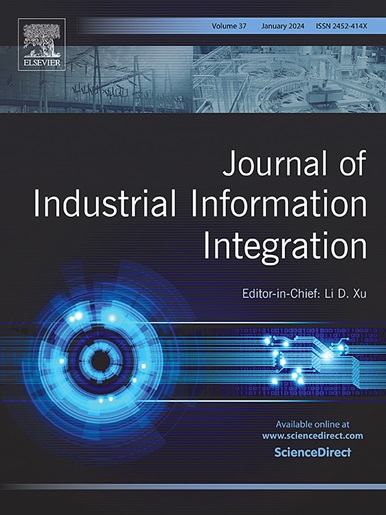Machine learning knowledge driven investigation for immunity infused fractional industrial virus transmission in SCADA systems
IF 10.4
1区 计算机科学
Q1 COMPUTER SCIENCE, INTERDISCIPLINARY APPLICATIONS
引用次数: 0
Abstract
Supervisory control and data acquisition (SCADA) environment is a highly sensitive and crucial industrial control system primarily deployed to monitor, control and automate the critically integrated and interconnected complex networks. Due to revolution in communication technology, SCADA systems encounter escalating cybersecurity threats and mandate proactive safeguard mechanisms to prevent cyberattack surfaces that may interrupt critical core services, maleficent equipment, and even threaten the social security in certain circumstances. This work aims to enhance the standard nonlinear industrial virus transmission (NIVT) model with immunity for SCADA systems by incorporating fractional‐order processing and then leveraging machine learning through nonlinear multilayer autoregressive exogenous (NM-ARX) neural networks iteratively trained with Bayesian regularization (BR)—the NM-ARX-BR methodology. The Caputo fractional differentiation operator inspired fractional implicit Adams–Moulton and explicit Adams–Bashforth multistep solvers are used to generate reference simulation dataset for NM-ARX-BR neuroarchitecture in case of fractional kinetic of immunity-based NIVT model with five dynamic states susceptible nodes S, enhanced-susceptible nodes E, latent nodes L, breakout nodes B, and recovered nodes R in the SCADA environment. The rigorous simulation based comprehensive comparative evaluation revealed that the low value of fitness on mean square error (MSE) in the range of 10−14 to 10−16 is achieved by NM-ARX-BR neurocomputational framework for sundry case studies of immunity-based NIVT system and performance is further validated by proximity analysis, cross correlation and autocorrelation analysis, histogram frequency distribution and regression statistics. The presented NM-ARX-BR framework depicts the resilience, accuracy, and consistency in modelling the fractional kinetics of immunity-based nonlinear industrial virus transmission in the SCADA systems by executing single and multiple step-ahead prediction measures during the exhaustive numerical simulations with error ranges of 10−13 to 10−16. The performance assessment is carried out utilizing three standard error metrics MSE, mean absolute error (MAE), root mean square error (RMSE) and phase space error (PSE). The error values of MSE, MAE, PSE and RMSE are remarkably low 10−07 to 10−09, demonstrate the robustness, generalization capability and high fidelity of NM-ARX-BR technique.

机器学习知识驱动的免疫注入工业病毒在SCADA系统中的传播研究
监控和数据采集(SCADA)环境是一个高度敏感和关键的工业控制系统,主要用于监控、控制和自动化关键集成和互联的复杂网络。由于通信技术的革命,SCADA系统面临着不断升级的网络安全威胁,需要主动保护机制来防止在某些情况下可能中断关键核心业务、恶意设备甚至威胁社会安全的网络攻击面。本工作旨在通过结合分数阶处理,然后利用机器学习,通过贝叶斯正则化(BR) - NM-ARX-BR方法迭代训练非线性多层自回归外生(NM-ARX)神经网络,增强SCADA系统的标准非线性工业病毒传播(NIVT)模型的免疫力。利用Caputo分数阶微分算子启发的分数阶隐式Adams-Moulton和显式Adams-Bashforth多步求解器,对SCADA环境下具有5个动态状态(敏感节点S、增强敏感节点E、潜伏节点L、爆发节点B和恢复节点R)的免疫NIVT模型的分数阶动力学生成NM-ARX-BR神经结构参考仿真数据集。基于严格仿真的综合对比评估表明,NM-ARX-BR神经计算框架在基于免疫的NIVT系统的各种案例研究中均方误差适应度(MSE)在10−14 ~ 10−16范围内达到了较低的值,并通过邻近分析、相互相关和自相关分析、直方图频率分布和回归统计进一步验证了性能。所提出的NM-ARX-BR框架通过在误差范围为10−13至10−16的详尽数值模拟中执行单步和多步超前预测措施,描述了在SCADA系统中基于免疫的非线性工业病毒传播的分数动力学建模中的弹性、准确性和一致性。性能评估采用三个标准误差指标MSE,即平均绝对误差(MAE),均方根误差(RMSE)和相空间误差(PSE)。MSE、MAE、PSE和RMSE的误差值均在10−07 ~ 10−09之间,具有较好的鲁棒性、泛化能力和高保真度。
本文章由计算机程序翻译,如有差异,请以英文原文为准。
求助全文
约1分钟内获得全文
求助全文
来源期刊

Journal of Industrial Information Integration
Decision Sciences-Information Systems and Management
CiteScore
22.30
自引率
13.40%
发文量
100
期刊介绍:
The Journal of Industrial Information Integration focuses on the industry's transition towards industrial integration and informatization, covering not only hardware and software but also information integration. It serves as a platform for promoting advances in industrial information integration, addressing challenges, issues, and solutions in an interdisciplinary forum for researchers, practitioners, and policy makers.
The Journal of Industrial Information Integration welcomes papers on foundational, technical, and practical aspects of industrial information integration, emphasizing the complex and cross-disciplinary topics that arise in industrial integration. Techniques from mathematical science, computer science, computer engineering, electrical and electronic engineering, manufacturing engineering, and engineering management are crucial in this context.
 求助内容:
求助内容: 应助结果提醒方式:
应助结果提醒方式:


